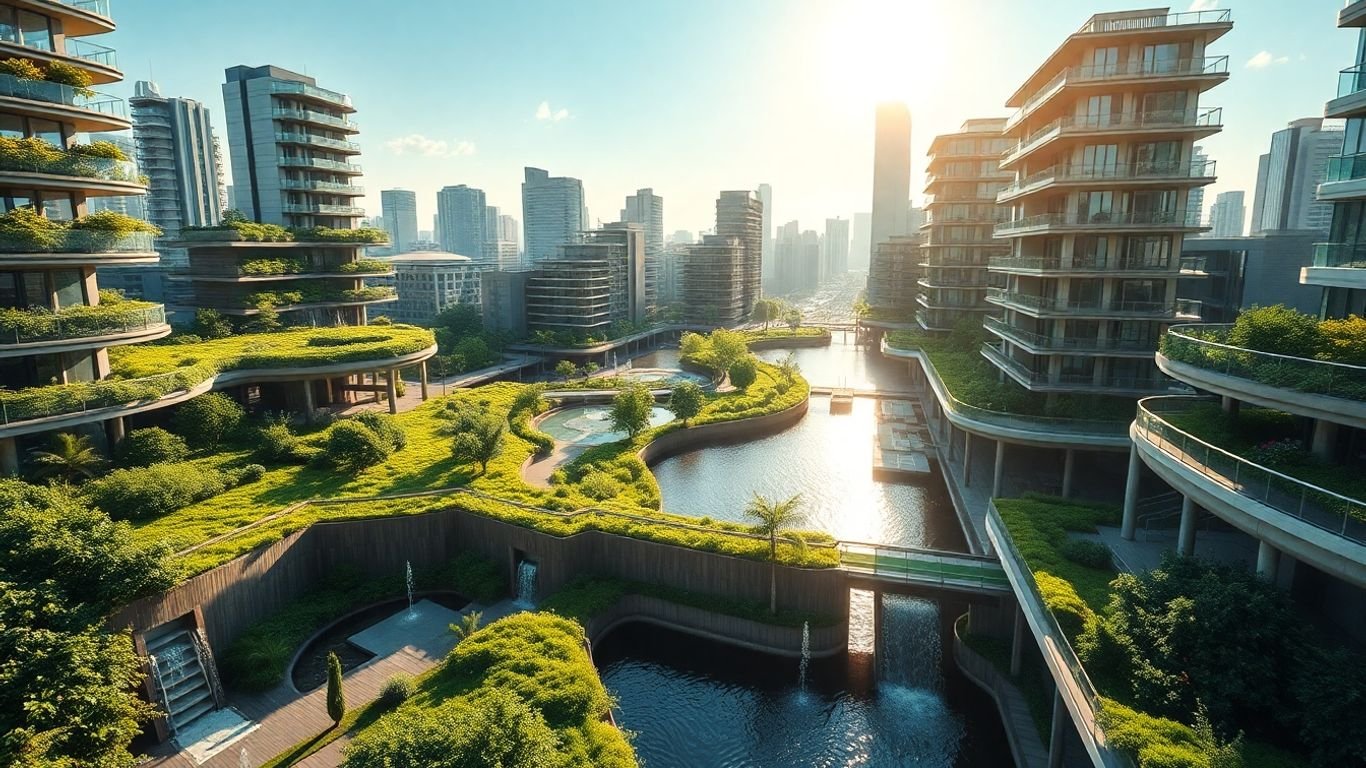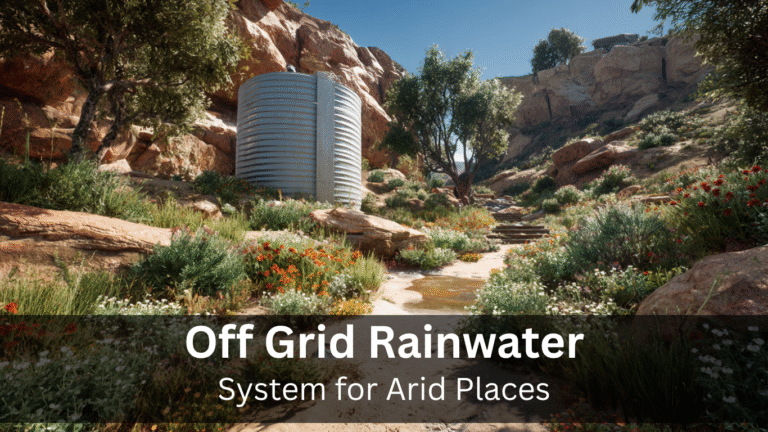Climate-Adaptive Cites: A Comprehensive Guide
Cities are feeling the heat, literally. As the climate changes, urban areas are on the front lines, facing everything from hotter summers to wilder weather. It’s not just about surviving these changes, but actually getting better at handling them. This means rethinking how we build, plan, and live in our cities to make sure they can handle whatever comes their way. We’re talking about creating climate-adaptive cities – places that are tough, smart, and ready for the future. For in-depth resources and case studies on climate adaptation in urban environments, visit the European Climate-ADAPT platform
Key Takeaways
- Climate-adaptive cities are designed to handle climate change impacts, like extreme heat, by being flexible and quick to respond.
- Building these cities means looking ahead, managing resources wisely, and getting everyone involved in the process.
- Using nature, like green spaces and natural systems, is a smart way to make cities more resilient and livable.
- Good leadership and strong community ties are super important for making adaptation plans work on the ground.
- New ideas, technology, and shifting to a greener economy can help cities adapt and thrive, even with climate challenges.
Defining Climate-Adaptive Cities
So, what exactly is a climate-adaptive city? It’s not just about having a few more trees or better drainage, though those things help. Think of it as a city that’s really good at rolling with the punches when it comes to climate change. It’s about being prepared for the weird weather, the rising temperatures, and all the other shifts that are happening. It’s a city built to handle change, not just survive it.
Understanding Urban Resilience
Urban resilience is basically a city’s ability to bounce back from tough times. These tough times can be sudden shocks, like a major flood or a heatwave, or they can be ongoing stresses, like slowly rising sea levels or more frequent droughts. A resilient city can keep its essential services running, its people safe, and its economy going, even when things get rough. It’s about having systems in place that can bend without breaking.
Key Characteristics of Adaptive Urban Environments
What makes a city truly adaptive? It’s a mix of things. For starters, these cities are good at planning ahead. They don’t just react; they anticipate. They also manage their resources smartly, making sure they have what they need without wasting it. And importantly, they get their people involved. When everyone has a say and understands what’s going on, the whole city is stronger.
Here are some of the main features:
- Forward-thinking planning: Looking at future climate scenarios and planning city development around them.
- Smart resource use: Efficiently managing water, energy, and waste.
- Community involvement: Making sure residents and local groups are part of the decision-making process.
- Flexibility: Being able to adjust plans and infrastructure as conditions change.
A city that’s truly adaptive doesn’t just build walls against problems; it learns to work with nature and its own systems to find solutions that last. It’s about being smart and flexible.
The Process of Climate Adaptation
Climate adaptation isn’t a one-time fix; it’s an ongoing process. It involves understanding the risks a city faces, figuring out what needs to be done, and then actually doing it. This might mean updating building codes, creating more green spaces, or improving public transportation. It’s a cycle of learning, planning, and acting, often involving trial and error. The goal is to reduce vulnerability and make the city a better, safer place for everyone, no matter what the climate throws at us.
Foundational Elements of Climate-Adaptive Cities
So, what makes a city truly ready for whatever the climate throws at it? It’s not just about having fancy green buildings, though those help. It really boils down to a few core ideas that need to be in place before anything else. Think of these as the bedrock upon which a resilient city is built.
Foresight and Future Planning
This is all about looking ahead, not just to next year, but decades down the line. It means anticipating how weather patterns might shift, where sea levels might rise, or when extreme heat waves could become the norm. It’s about asking tough questions now so we don’t get blindsided later. This isn’t just guesswork; it involves using data, modeling, and a good dose of common sense to map out potential futures. A city that plans for the future is a city that can adapt.
- Scenario Planning: Developing different possible future climate conditions to test city plans against.
- Infrastructure Design: Building roads, power grids, and water systems that can handle more extreme weather.
- Policy Development: Creating regulations and incentives that encourage climate-smart choices.
We need to move beyond just reacting to problems. True adaptation means proactively shaping our cities to thrive, not just survive, in a changing world. This requires a shift in mindset from short-term fixes to long-term vision.
Effective Resource Management
Cities use a lot of resources – water, energy, land. Managing these wisely is key to resilience. It means cutting down on waste, finding more efficient ways to use what we have, and making sure our resource systems can keep up even when things get tough. Think about water conservation during droughts or ensuring our energy grids can handle peak demand during heatwaves. It’s about being smart with what we’ve got.
- Water Systems: Implementing water recycling, rainwater harvesting, and efficient irrigation.
- Energy Grids: Promoting renewable energy sources and improving grid reliability.
- Waste Reduction: Focusing on circular economy principles to minimize landfill.
Stakeholder Engagement and Participation
No city can become climate-adaptive without its people. This means involving everyone – residents, businesses, community groups, and government agencies – in the planning and decision-making process. When people have a say, they’re more likely to support and participate in adaptation efforts. It’s about building a shared sense of responsibility and ensuring that solutions work for everyone, not just a select few. This bottom-up approach is often where the most practical and effective ideas come from.
- Community Workshops: Holding regular meetings to gather input and share information.
- Public Consultations: Providing clear channels for feedback on proposed plans.
- Partnership Building: Collaborating with local organizations and businesses on adaptation projects.
Strategies for Building Climate Resilience
So, how do we actually make our cities tougher against a changing climate? It’s not just about building higher walls or stronger roofs, though that’s part of it. We’re talking about smarter, more integrated approaches. Think of it like building a healthy body – you need strong bones, good circulation, and a way to fight off illness. For cities, that means looking at our green spaces, how we use land, and how we design things from the ground up.
Integrating Green Infrastructure
This is where nature meets the built environment. Green infrastructure isn’t just about pretty parks, though those are nice too. It’s about using natural systems to do jobs that traditional
Governance and Social Dynamics in Adaptation
When we talk about making cities ready for climate change, it’s not just about building sea walls or planting trees. We also need to think about how people and systems work together. This section looks at how cities are run and how communities interact to build resilience.
Decentralized Management Approaches
Trying to manage climate adaptation from one central office can get pretty complicated, especially in big cities. That’s why many places are looking at spreading out the decision-making. This means giving more power to local neighborhoods or specific districts to figure out what works best for them. It’s about making sure that plans are tailored to the actual risks and needs on the ground, rather than a one-size-fits-all approach.
- Local governments get more say in adaptation planning.
- Decision-making is spread out, not just at the top.
- Plans are more specific to local conditions and risks.
This kind of setup helps because the people who live and work in an area often know its challenges best. They can spot problems and come up with solutions that make sense for their community. It’s about making sure that adaptation efforts are practical and actually get done.
Strengthening Social Cohesion
When a community is well-connected and people look out for each other, it’s much better equipped to handle tough times, including climate shocks. Social cohesion means having strong relationships, trust, and a sense of belonging. In cities, this can look like community groups working together, neighbors helping each other during extreme weather, or shared spaces where people can connect.
Building strong social ties isn’t just a nice-to-have; it’s a practical way to boost resilience. When people trust each other and have networks, they can share information, resources, and support more effectively when disaster strikes. This collective strength is a powerful asset.
Think about it: if a heatwave hits, a cohesive neighborhood might have systems in place to check on elderly residents or share cooling centers. If a flood occurs, people might already know who has a boat or who can offer shelter. These informal networks are incredibly important.
Community-Based Planning
This is where the rubber meets the road. Community-based planning means actively involving the people who live in a city in the process of figuring out how to adapt to climate change. It’s not just about telling people what’s happening; it’s about listening to their ideas, using their local knowledge, and making them part of the solution.
Here are some ways this plays out:
- Using Local and Indigenous Knowledge: People who have lived in an area for a long time often have a deep understanding of its environment, its patterns, and its vulnerabilities. This traditional knowledge can be incredibly useful for planning. For example, knowing which areas flood most often or how certain plants react to changing weather.
- Participatory Research: Instead of experts coming in and telling everyone what to do, community members can work alongside researchers. This helps ensure that the data collected is relevant and that the solutions developed are practical for the people who will use them.
- Empowering Local Voices: Giving communities a real say in decisions that affect them builds trust and ownership. When people feel heard and valued, they are more likely to support and participate in adaptation projects. This can involve workshops, public meetings, or even digital platforms for feedback.
Ultimately, successful climate adaptation relies on both smart governance and strong communities working hand-in-hand.
Innovation and Economic Considerations

Cities are finding new ways to tackle climate change, and it’s not just about big government plans. A lot of smart ideas are coming from businesses and local communities. We’re seeing a real shift towards technologies that help us use less energy and produce fewer emissions. This means looking at everything from how we build our homes to how we power our cities. For example, some places are really pushing for cleaner energy sources, like hydro power, to replace older, dirtier methods. It’s about making smart investments now for a better future.
Leveraging Emerging Technologies
New tech is popping up everywhere to help cities adapt. Think about smart grids that manage electricity use better, or apps that help track how much energy buildings are using. Cities are also looking at things like advanced water meters to manage our water supply more efficiently. It’s not just about having the tech, though; it’s about figuring out how to actually use it. Many cities are becoming like little labs, testing out new solutions to see what works best. They’re working with companies that specialize in clean tech to try out new ideas, like ways to reuse building materials instead of throwing them away. This creates new jobs and helps the environment at the same time. We’re seeing cities invest more in these kinds of solutions, which is a good sign.
The Role of a Low-Carbon Economy
Moving towards a low-carbon economy is a big part of becoming a climate-adaptive city and achieving carbon-neutral cities. This means shifting away from relying on fossil fuels and embracing cleaner ways of doing things. It’s about creating jobs that are good for the planet, like those in renewable energy or sustainable building. Even existing jobs can be made greener. The goal is to work in ways that use fewer resources and create less pollution. This isn’t just an environmental issue; it’s also an economic one. Cities that lead in this area can attract new businesses and become more competitive.
Economic Dimensions of Climate Policy
When cities make policies about climate change, they have to think about the money involved. This includes figuring out how to pay for new infrastructure, like better public transport or more green spaces. It also means looking at the costs and benefits of different approaches. Sometimes, making buildings more energy-efficient can save money in the long run through lower utility bills. Cities are also looking at financial incentives to encourage people and businesses to make greener choices. It’s a balancing act, trying to protect the environment while also keeping the economy strong. The Sea to Sky Gondola’s move to hydro power is a good example of an investment in long-term sustainability [6e03].
Here’s a quick look at how some cities are investing:
| Area of Investment | Percentage of Cities Investing |
|---|---|
| Energy Usage Apps | 78% |
| Smart Water Meters | 69% |
| Smart Grids & Meters | 67% |
Adapting to climate change isn’t just about reacting to problems. It’s about proactively building cities that can handle future challenges. This involves smart planning, using new technologies, and making economic choices that support a healthier planet. It’s a complex puzzle, but one that cities are increasingly figuring out.
Challenges and Opportunities in Adaptation

Building cities that can handle a changing climate isn’t a walk in the park. There are some pretty big hurdles to jump over, but on the flip side, there are also some really exciting possibilities that come with tackling these issues head-on.
Addressing Financial and Institutional Barriers
Let’s be real, adaptation costs money. A lot of it. Cities often struggle to find the cash for big projects like upgrading drainage systems or building sea walls. It’s not just about the upfront cost, either. Keeping these systems running and maintained over time adds another layer of expense that can strain city budgets. Then there’s the whole institutional side of things. Sometimes, different city departments don’t talk to each other, or old rules and regulations get in the way of new, smarter ways of doing things. It can be a real headache trying to get everyone on the same page and moving in the same direction.
- Securing consistent funding for adaptation projects.
- Developing flexible policies that can adapt to changing needs.
- Streamlining bureaucratic processes to speed up implementation.
The sheer scale of investment needed for climate adaptation often outstrips the available public funds. This means cities have to get creative, looking for partnerships with the private sector and exploring innovative financing mechanisms. It’s a tough balancing act, but necessary for long-term resilience.
Mitigating Social Inequalities
Climate change doesn’t hit everyone equally. Often, it’s the folks in lower-income neighborhoods or marginalized communities who are hit the hardest. They might live in areas more prone to flooding, have less access to resources, or lack the political clout to get their needs addressed. So, when we talk about adaptation, we have to make sure we’re not leaving anyone behind. Building resilience means building it for everyone, and that requires a conscious effort to address existing social and economic divides.
Here’s a look at how inequality can play out:
- Vulnerable populations often reside in higher-risk areas. This could be due to historical housing policies or economic factors. For example, areas near rivers or coastlines might be more affordable but also more susceptible to extreme weather events.
- Limited access to information and resources. Communities with fewer resources may not have access to early warning systems, evacuation plans, or the financial means to recover after a disaster.
- Disproportionate impact on health. Heatwaves, for instance, can be far more dangerous for individuals without access to air conditioning or adequate healthcare.
Transformative Potential of Urban Resilience
While the challenges are significant, the push for climate adaptation also presents a massive opportunity to rethink and rebuild our cities for the better. It’s a chance to move beyond just patching things up and instead create urban environments that are more sustainable, equitable, and livable for everyone. Think about it: investing in green infrastructure not only helps manage stormwater but also creates beautiful parks and cleaner air. Shifting to renewable energy sources can create new jobs and reduce pollution. By embracing adaptation, cities can become more innovative, economically vibrant, and ultimately, better places to call home. It’s about turning a crisis into a catalyst for positive change.
Moving Forward: Building Our Climate-Ready Cities
So, what does all this mean for our cities? Basically, building a climate-adaptive city isn’t just about fancy tech or big government plans. It’s about smart planning, using what we have wisely, and getting everyone involved. Think of it like preparing for a big storm – you need to know what might happen, have a plan, and make sure your neighbors are ready too. This means looking ahead, managing our resources better, and making sure our communities can handle whatever the weather throws at us. It’s a big job, for sure, but by working together and keeping these ideas in mind, we can build cities that are not just surviving, but actually thriving, no matter what the future climate brings.
Frequently Asked Questions
What exactly is a climate-adaptive city?
Think of a climate-adaptive city as a city that’s prepared for changes in our weather, like hotter summers or stronger storms. It’s a city that can handle these changes without falling apart and can bounce back quickly if something bad happens. It’s about making sure the city can keep running smoothly and keep its people safe, no matter what the climate throws at it.
Why is planning ahead so important for these cities?
Planning ahead is like having a roadmap. For climate-adaptive cities, it means looking into the future to see what kind of weather challenges might come up. This helps city leaders make smart choices now, like using cleaner energy or building better flood defenses, so they don’t have bigger problems later on. It’s about being proactive instead of just reacting.
What does ‘urban resilience’ mean in simple terms?
Urban resilience is basically a city’s ability to bounce back from tough times. These tough times could be anything from a big storm to a heatwave, or even other problems like power outages. A resilient city has the strength and flexibility to get through these challenges and keep things going, and even get better because of what it learned.
How do cities use nature to help them adapt to climate change?
Cities can use nature in smart ways! This includes things like planting more trees to cool down hot areas, creating green roofs on buildings to absorb rainwater, or restoring wetlands to help manage floods. These ‘nature-based solutions’ not only help the city adapt but also make it a more beautiful and healthier place to live.
Who needs to be involved in making a city climate-adaptive?
Lots of people! Making a city ready for climate change isn’t just a job for the government. It involves everyone – the people who live there, businesses, community groups, and city officials. When everyone works together and shares their ideas, the city can come up with better plans that work for everybody.
Are there any downsides or difficulties in making cities climate-adaptive?
Yes, it’s not always easy. Sometimes cities don’t have enough money to make all the needed changes. Other times, there might be rules or old ways of doing things that make it hard to try new ideas. Also, it’s important to make sure that the changes help everyone in the city, not just a few people, so that no one gets left behind.








